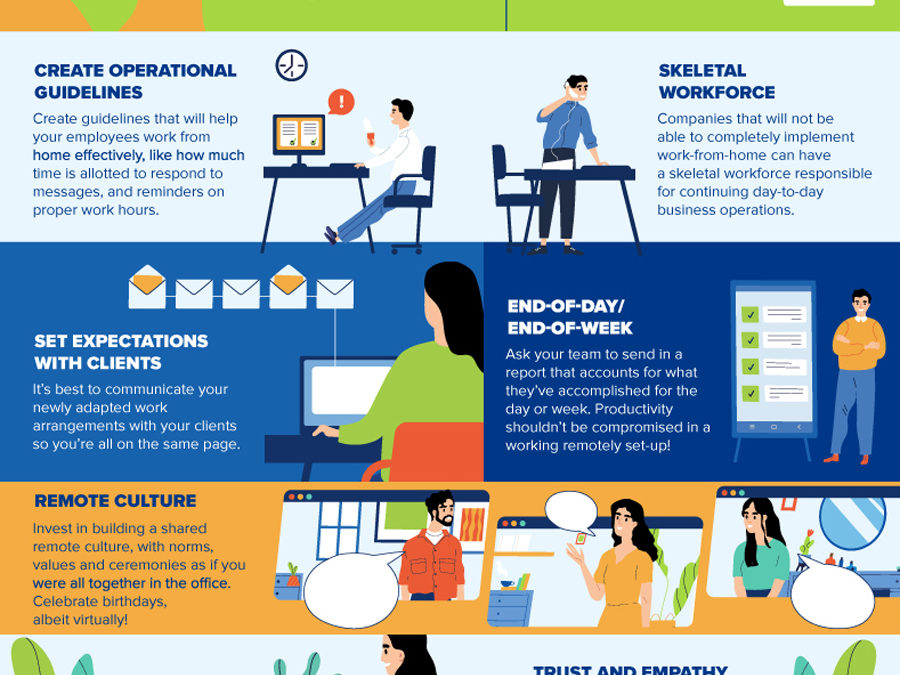Working from home has turned from a simple working option for some to a necessity for most as a result of the ongoing coronavirus pandemic and government-mandated quarantine. To help companies with this setup, Paul Rivera, ex-Googler, Kalibrr CEO and Co-founder recommends these easy-to-implement tips to ensure employee well-being, accountability, and productivity as they work remotely.
Access to tools and technology
Everyone should have access to the same set of tools – in our case, laptops, company email addresses, phones/SIM cards for our sales team, access to cloud storage (Google Drive / Dropbox), access to the company-wide project management tool like Trello, and in some cases, subsidized access to the internet.
Align on what communication channels to use
Communication is a critical piece to make sure that working remotely goes as smoothly as possible. Are you going to use Skype, Slack Viber, or Telegram? Whatever you choose, make sure that you clearly and deliberately assign specific channels that you’ll be using to talk to your employees.
Create concrete communication and operational guidelines
Once you’ve identified the right channels, you’ll need to have guidelines that will accompany these. This can include how much time is allotted to respond to messages and emails together with set break times for when slowed down responses should be anticipated. Objectives and their milestones should be communicated using the channels and methods above. It’s also easy to overdue work from home – work from home shouldn’t mean that your team is always working.
Set processes for “reporting to work”
The whole company should treat this as if they are going to work – showering, dressing and all of the pre-work rituals should continue to be ovserved. Regular work hours should be followed so you shouldn’t have to ask employees to “check-in.” However, if you’re new to this, asking your employees to send in an email message or message to your group that they’re already online and working can quickly ease this administrative burden.
Assign a skeletal workforce
Not all companies will be able to completely implement a work-from-home setup. Having a skeletal workforce responsible for continuing day-to-day business operations will be helpful to minimize both health risks and business losses.
Communicate your work arrangement to your clients
Make sure to set expectations with your clients and partners in line with the work arrangement you’ll be implementing. Sending an email signed by management to these stakeholders can be greatly appreciated.
End-of-day / End-of-week check-in
Working remotely should not reduce your overall business productivity. Asking your team to send in an end-of-day report that outlines what they’ve accomplished for the day helps you keep track of company goals but at the same time helps employees manage their own responsibilities better. Better yet, if you use a project management tool like Trello, the reports should happen within the system you’ve already established while you were all working in the office.
Create a remote culture
Invest in building a shared remote culture, with norms, values and ceremonies as if you were all together in the office. If it is someone’s birthday, it should still be celebrated, albeit on a video chat with a virtual birthday cake. In addition, create an accountability culture where team members collaborate, are transparent and invest in each other’s success.
Trust and Empathy
Trust that people will get their work done and understand if they need help. This is probably going to be the hardest part for many companies but engendering trust can go a long way to making this work for your company. Make sure your employees feel empowered to speak up if something isn’t working for them and you should also speak up if it isn’t working for you.
Recommended Free Tools:
Video conferencing: Zoom / Google Hangouts / Skype / Discord
Project management: Trello / Notion
Communication: Viber / WhatsApp / Telegram / Messenger / Google Hangouts Chat
Whiteboard: Jamboard, Miro, Whimsical
Pandemic or not, being open and trusting of employees will also encourage them to be more accountable for their business contributions as they work from home.
As Paul often shares, “with the amount of technology available, the future of work isn’t necessarily everyone in one office from 9-6 pm, watching the clock. The future of work is an empowered team, who you trust and who hold each other accountable, with the right tools to be productive, regardless of where they may be.”
Liked this post? Follow SwirlingOverCoffee on Facebook, YouTube, and Instagram.


